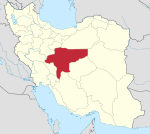Golpayegan County
Golpayegan County
شهرستان گلپایگان | |
|---|---|
 Golpayegan petroglyphs | |
 Location of Golpayegan County in Isfahan province | |
 Location of Isfahan province in Iran | |
| Coordinates: 33°27′N 50°20′E / 33.450°N 50.333°ECoordinates: 33°27′N 50°20′E / 33.450°N 50.333°E | |
| Country | |
| Province | Isfahan |
| Capital | Golpayegan |
| Districts | 1 (2006) |
| Population (2016) | |
| • Total | 90,086 |
| Time zone | UTC+3:30 (IRST) |
| • Summer (DST) | UTC+4:30 (IRDT) |
| Golpayegan County can be found at GEOnet Names Server, at this link, by opening the Advanced Search box, entering "9205998" in the "Unique Feature Id" form, and clicking on "Search Database". | |
Golpayegan County (Persian: شهرستان گلپایگان) is located in Isfahan province, Iran. The capital of the county is Golpayegan. At the 2006 census, the county's population was 82,601, in 24,701 families.[1] At the 2016 census, the county's population was 90,086, in 30,419 households.[2]
Administrative divisions
| Administrative Divisions | Pop. |
|---|---|
| Central District | 82,601 |
| Jolgeh Rural District | 4,021 |
| Kenarrudkhaneh Rural District | 8,721 |
| Nivan Rural District | 5,358 |
| Golpayegan City | 47,849 |
| Golshahr City | 9,966 |
| Guged City | 6,686 |
| Total Golpayegan County | 82,601 |
Earthquake of Golpāyagen
The county's rural areas were devastated in the earthquake of 715 H/1316 AD [3] According to Mostawfi,[4] in 740 H/1339-40 AD Golpāyegān had some fifty villages, yielding the annual revenue of 42,000 dinars to the state, hinting that the city was very wealthy.
Location, climate and demography
Golpāyegān is located in Isfahan province, bordered on the south by the Bakhtiaris mountains and Khvansar County, on the east by the county of Barḵhar and Meyma, on the north by the counties of Mahallat and Khomein (Kamare), and on the west by Aligudarz county (province of Lorestān).
It comprises 3 rural districts (Jolge, Kenarruhkhune, nivuun) جلگه، کنار رودخونه، نیوون and 3 towns, namely, Gugad, Golshahr, and Golpāyegān. Persian: گوگد، گلشهر، گلپایگان
In 1237 H/1821-22 AD, Golpāyegān had some 2,000 households,[5] its population in 1324-25 H/1906-7 AD was 12,000 to 15,000. In 1996 AD the county had a population of 84,081 people, of whom 45,756 lived in urban areas [6]
Ghebla River
The most important river of Golpāyegān (Ghebla River), runs through the county, irrigating Khomein, Delijān, and Mahallat, before eventually emptying into the Gav ḵhuni salt swamp near Isfahan
Golpayegan Dam (Sade Golpayegan)
A dam Persian: سد گلپایگان 57 meter high has been constructed on this river at Aḵhteḵhun, located 18 km southeast of Golpāyegān .
Golpayegan's Dam, made by Engineer Aligholi Baiani[7] (مهندس علینقی بیانی), is the first modern dam in Iran. Irrigation in the area is by qanāt (in Persian:قنات / کاریز), well, and spring waters.
Agricultural products
Agricultural products include wheat, cotton, barley, grains, sugar, beets, and various kinds of fruits.
(apricots, apples, pears, cherries, cantaloupes, cucumbers, grapes, sour cherries, watermelons...)
Golpayegan has lot of Jeliz (in Persian: جیلیز Jeliz = Fruit and Vegetable Garden.[8]
Animal husbandry is also practiced. The region has stands of mountain-almond, (in Persian:بادام کوهی
wild fig, and barberry, as well as wild thyme, London rocket seed khak shir, milk-vetch,(in Persian:خاکشیر) bugloss, and gum-tragacanth plants.
The jackal, fox, wolf, and rabbit are among the wild animals found in the surrounding areas. There are also gold, silver, and gypsum deposits.
Golpayegan is famous (not only for Kabab, Kalle Pache (in Persian:کله پاچه) (sheep head, Khash), or Helium turkey...) is famous for its beautiful Persian rugs.
Handicrafts include carpet-weaving, giva (گیوه) cotton-shoe production, and wood-carving, Wood Sculpture, inlaid wood and embossed works.
References
- ^ a b "Census of the Islamic Republic of Iran, 1385 (2006)" (Excel). Statistical Center of Iran. Archived from the original on 2011-11-11.
- ^ "Census 2016 | Iran Data Portal". Retrieved 2020-11-18.
- ^ Nicholas N. Ambraseys and Charles P. Melville, A History of Persian Earthquakes, Cambridge, 1982; tr. A. Rada as Tāriḵ-e zamin-larzahā-ye Irān, Tehran, 1370 Š./1991
- ^ (Nozhat al-qolub, ed. Le Strange, p. 68)
- ^ ( Zayn-al-ʿĀbedin Eskandar Širvāni, Riāż al-siāḥa, Tehran, 1339 Š./1960, p. 707)
- ^ (Markaz-e āmār ,1996, p. 10).
- ^ سیمای فرزانگان – مهندس علیقلی بیانی، فرزانهای از جنس آب. علی اکبر جعفری . صدای گلپایگان
- ^ The name of Jeliz (Jaliz) is in Shahnameh Ferdowsi. PALIZ
به پالیز بلبل بنالد همی
گل از ناله ٔ او ببالد همی
فردوسی
